automatic transmission fluid CHEVROLET ASTRO 1998 2.G Owners Manual
[x] Cancel search | Manufacturer: CHEVROLET, Model Year: 1998, Model line: ASTRO, Model: CHEVROLET ASTRO 1998 2.GPages: 414, PDF Size: 21.46 MB
Page 220 of 414
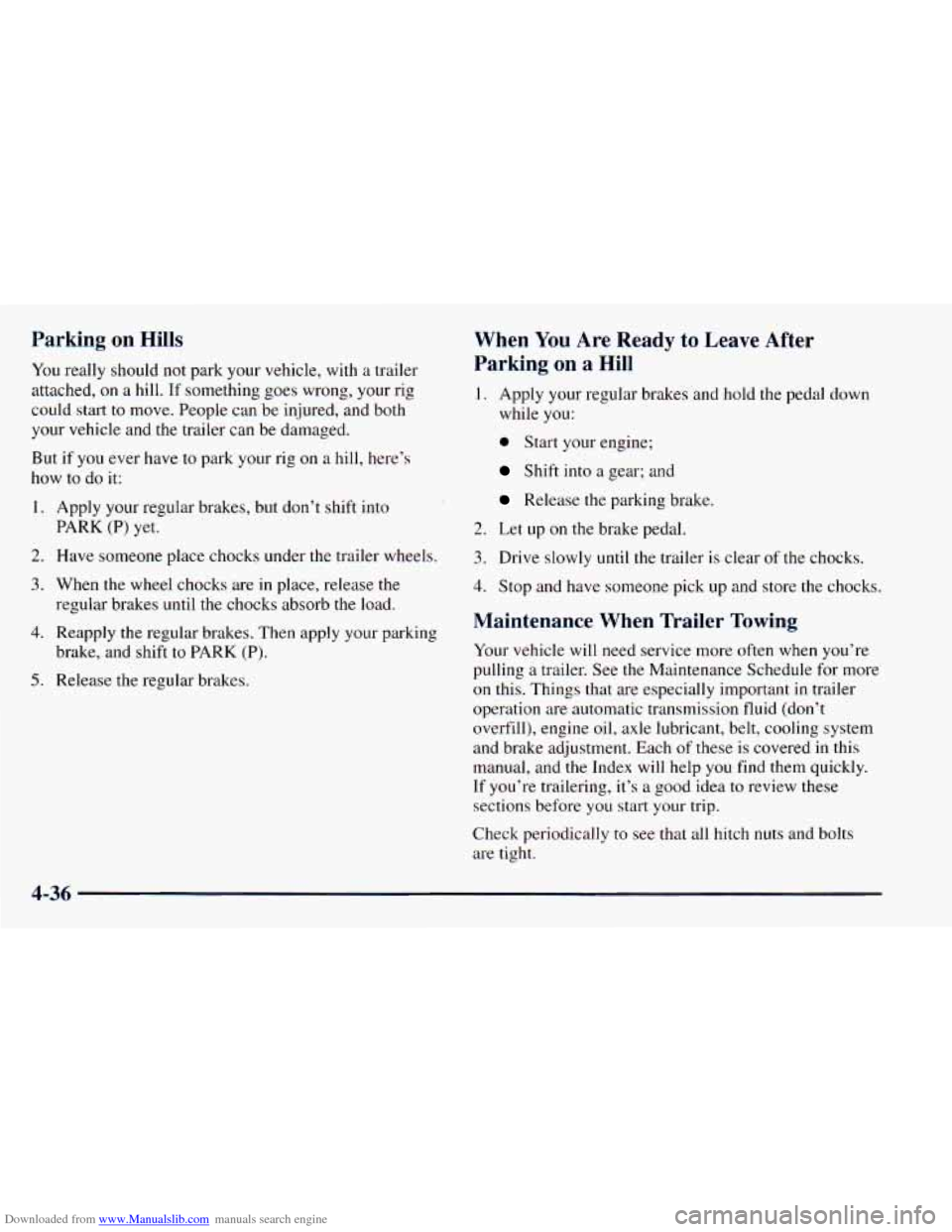
Downloaded from www.Manualslib.com manuals search engine Parking on Hills
You really should not park your vehicle, with a trailer
attached,
on a hill. If something goes wrong, your rig
could start
to move. People can be injured, and both
your vehicle and
the trailer can be damaged.
But if you ever have
to park your rig on a hill, here’s
how to do
it:
1. Apply your regular brakes, but don’t shift into
2. Have someone place chocks under the trailer wheels.
3. When the wheel chocks are in place, release the
regular brakes until the chocks absorb the load.
4. Reapply the regular brakes. Then apply your parking
brake, and shift to
PARK (P).
5. Release the regular brakes.
PARK (P) yet.
When You Are Ready to Leave After
Parking on a Hill
1. Apply your regular brakes and hold the pedal down
while
you:
0 Start your engine;
Shift into a gear; and
Release the parking brake.
2. Let up on the brake pedal.
:ks.
3. Drive slowly until the trailer is clear of the choc
4. Stop and have someone pick up and store the chocks.
Maintenance When Trailer Towing
Your vehicle will need service more often when you’re
pulling a trailer. See the Maintenance Schedule for more
on this. Things that are especially important in trailer
operation are automatic transmission fluid (don’t
overfill), engine oil, axle lubricant, belt, cooling system
and brake adjustment. Each
of these is covered in this
manual, and the Index will help
you find them quickly.
If you’re trailering, it’s a good idea
to review these
sections before you start your trip.
Check periodically to see that all hitch nuts and bolts
are tight.
4-36
Page 226 of 414
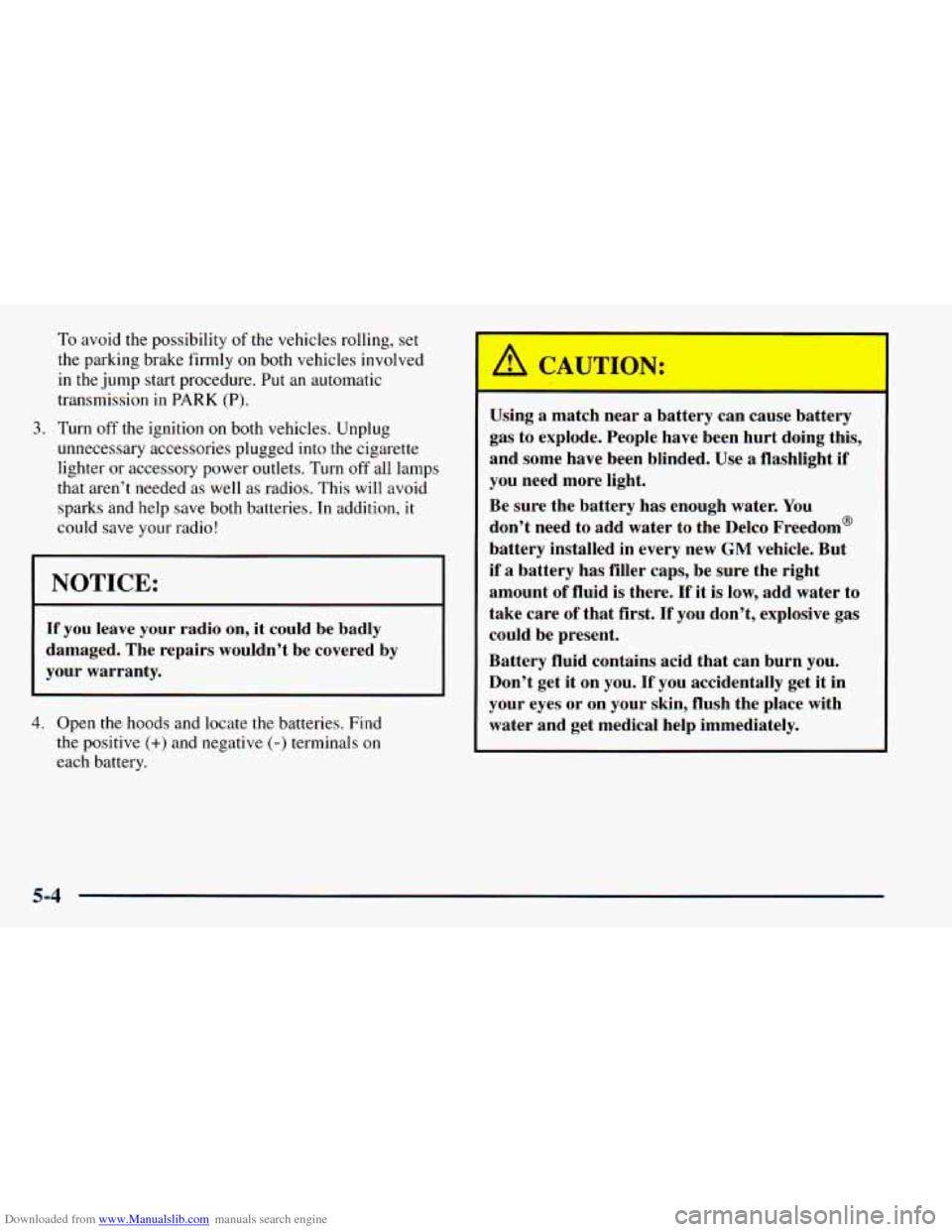
Downloaded from www.Manualslib.com manuals search engine To avoid the possibility of the vehicles rolling, set
the parking brake firmly on both vehicles involved
in the jump start procedure. Put an automatic
transmission in PARK
(P).
3. Turn off the ignition on both vehicles. Unplug
unnecessary accessories plugged into the cigarette
lighter or accessory power outlets. Turn
off all lamps
that aren’t needed as well as radios. This will avoid
sparks and help save both batteries.
In addition, it
could save your radio!
NOTICE:
If you leave your radio on, it could be badly
damaged. The repairs wouldn’t be covered by
your warranty.
4. Open the hoods and locate the batteries. Find
the positive
(+) and negative (-) terminals on
each battery.
A CAUTION:
1 ng a match near a battery can cause battery
gas to explode. People have been hurt doing this,
and some have been blinded. Use a flashlight if
you need more light.
Be sure the battery has enough water. You
don’t need to add water to the Delco Freedom@
battery installed in every new
GM vehicle. But
if a battery has filler caps, be sure the right
amount of fluid is there.
If it is low, add water to
take care of that first.
If you don’t, explosive gas
could be present.
Battery fluid contains acid that can burn you.
Don’t get it on you.
If you accidentally get it in
your eyes or on your skin, flush the place with
water and get medical help immediately.
Page 263 of 414
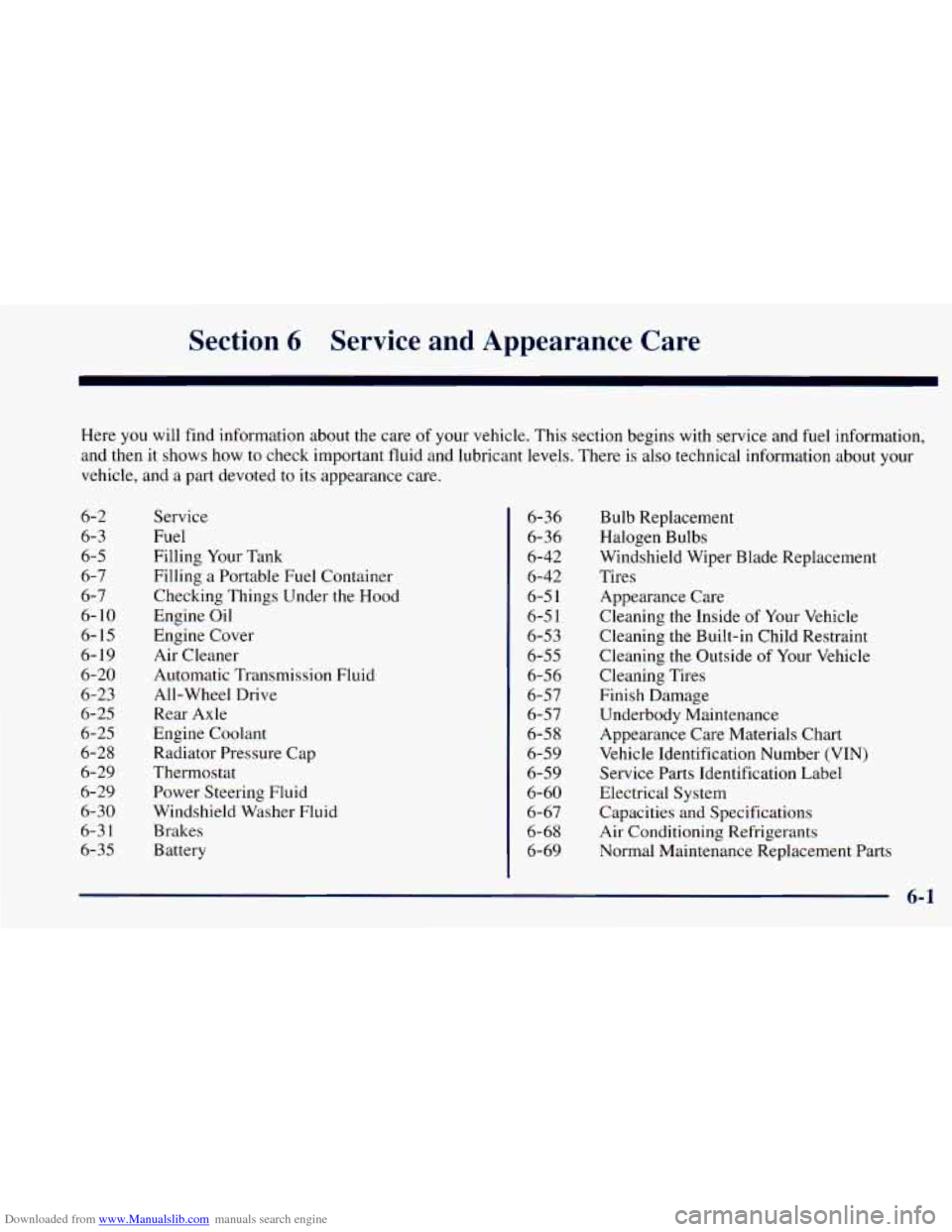
Downloaded from www.Manualslib.com manuals search engine Section 6 Service and Appearance Care
Here you will find information about the care of your vehicle. This section begins with service and fuel information,
and then it shows how to check important fluid and lubricant levels. There is also technical infc lation about your
6-2
6- 3
6-
5
6-7
6-7
6- 10
6- 15
6- 19
6-20
6-23
6-25
6-25
6-28
6-29 6-29
6-30
6-3
1
6-35 vehicle,
and a part devoted to its appearance care.
Service
Fuel
Filling Your Tank
Filling a Portable Fuel Container
Checking Things Under the Hood
Engine Oil Engine Cover
Air Cleaner
Automatic Transmission Fluid
All-Wheel Drive
Rear Axle
Engine Coolant
Radiator Pressure Cap
Thermostat
Power Steering Fluid
Windshield Washer Fluid
Brakes
Battery 6-36
6-36
6-42
6-42
6-5 1
6-5
1
6-53
6-55
6-56
6-57
6-57
6-58
6-59
6-59 6-60
6-67
6-68
6-69 Bulb
Replacement
Halogen Bulbs
Windshield Wiper Blade Replacement
Tires
Appearance Care
Cleaning the Inside of Your Vehicle
Cleaning the Built-in Child Restraint
Cleaning the Outside
of Your Vehicle
Cleaning Tires
Finish Damage
Underbody Maintenance
Appearance Care Materials Chart
Vehicle Identification Number (VIN)
Service Parts Identification Label
Electrical System
Capacities and Specifications
Air Conditioning Refrigerants
Normal Maintenance Replacement Parts
6-1
Page 282 of 414
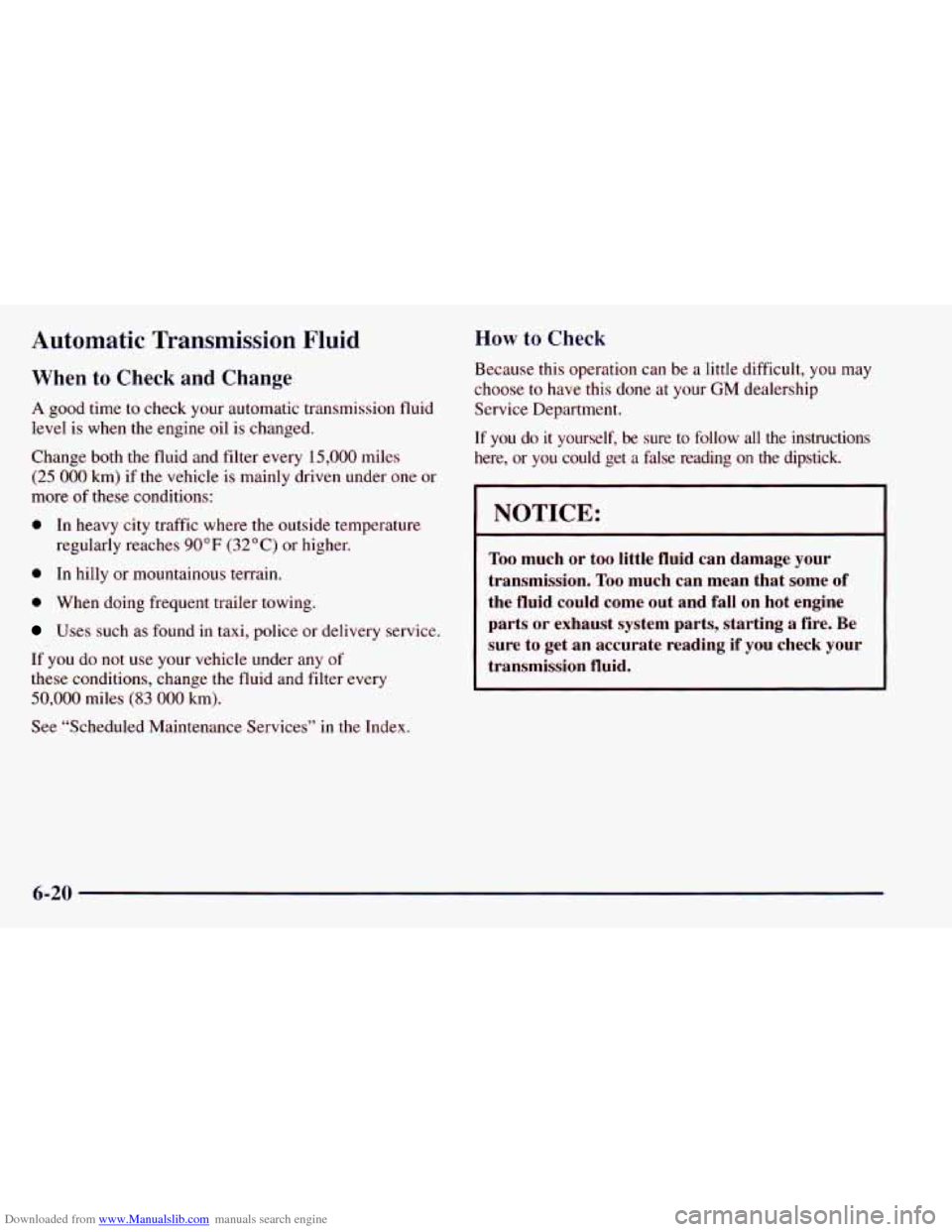
Downloaded from www.Manualslib.com manuals search engine Automatic Transmission Fluid
When to Check and Change
How to Check
Because this operation can be a little difficult, you may
choose
to have this done at your GM dealership ~
A good time to check your automatic transmission fluid Service Department.
level is when the engine oil
is changed.
Change both the fluid and filter every
15,000 miles here, or you could get a false reading on the dipstick.\
(25 000 km) if the vehicle is mainly driven under one or If
you do
it yourself, be sure to follow all the instructions
more of these conditions:
0 In heavy city traffic where the outside temperature
0 In hilly or mountainous terrain.
0 When doing frequent trailer towing.
regularly reaches
90°F (32 “C) or
higher.
NOTICE:
Too much or too little fluid can damage your
transmission.
Too much can mean that some of
the fluid could come out and fall on hot engine
Uses such as found in taxi, police or delivery service.
If you do not
use your vehicle under any of
these conditions, change the fluid and filter every
50,000 miles (83 000 km).
parts or exhaust system parts, starting a fire. Be
sure to get an accurate reading if you check your
transmission fluid.
See “Scheduled Maintenance Services’’ in the Index.
6-20
Page 285 of 414
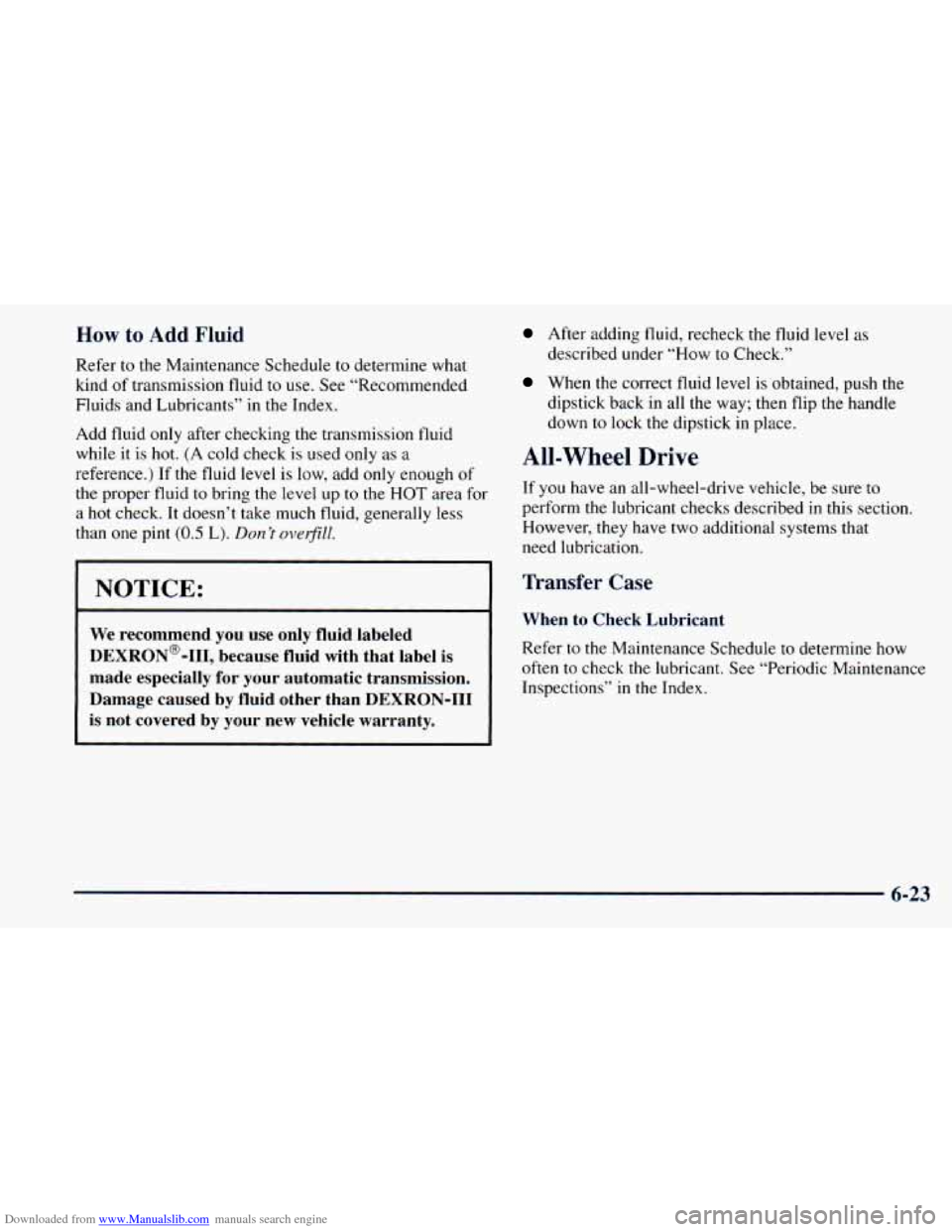
Downloaded from www.Manualslib.com manuals search engine How to Add Fluid
Refer to the Maintenance Schedule to determine what
kind of transmission fluid to use. See “Recommended
Fluids and Lubricants” in the Index.
Add fluid
only after checking the transmission fluid
while it is hot. (A cold check is used
only as a
reference.) If the fluid level is low, add only enough of
the proper fluid to bring the level up to the HOT area for
a hot check. It doesn’t take much fluid, generally less
than one pint
(0.5 L). Don’t overji11.
NOTICE:
We recommend you use only fluid labeled
DEXRON@-111, because fluid with that label is
made especially for your automatic transmission.
Damage caused by fluid other than DEXRON-I11
is not covered by your new vehicle warranty.
After adding fluid, recheck the fluid level as
described under “How
to Check.”
When the correct fluid level is obtained, push the
dipstick back in
all the way; then flip the handle
down to lock the dipstick in place.
All-Wheel Drive
If you have an all-wheel-drive vehicle, be sure to
perform
the lubricant checks described in this section.
However, they have two additional systems that
need lubrication.
Transfer Case
When to Check Lubricant
Refer to the Maintenance Schedule to determine how
often to check
the lubricant. See “Periodic Maintenance
Inspections” in the Index.
6-23
Page 329 of 414
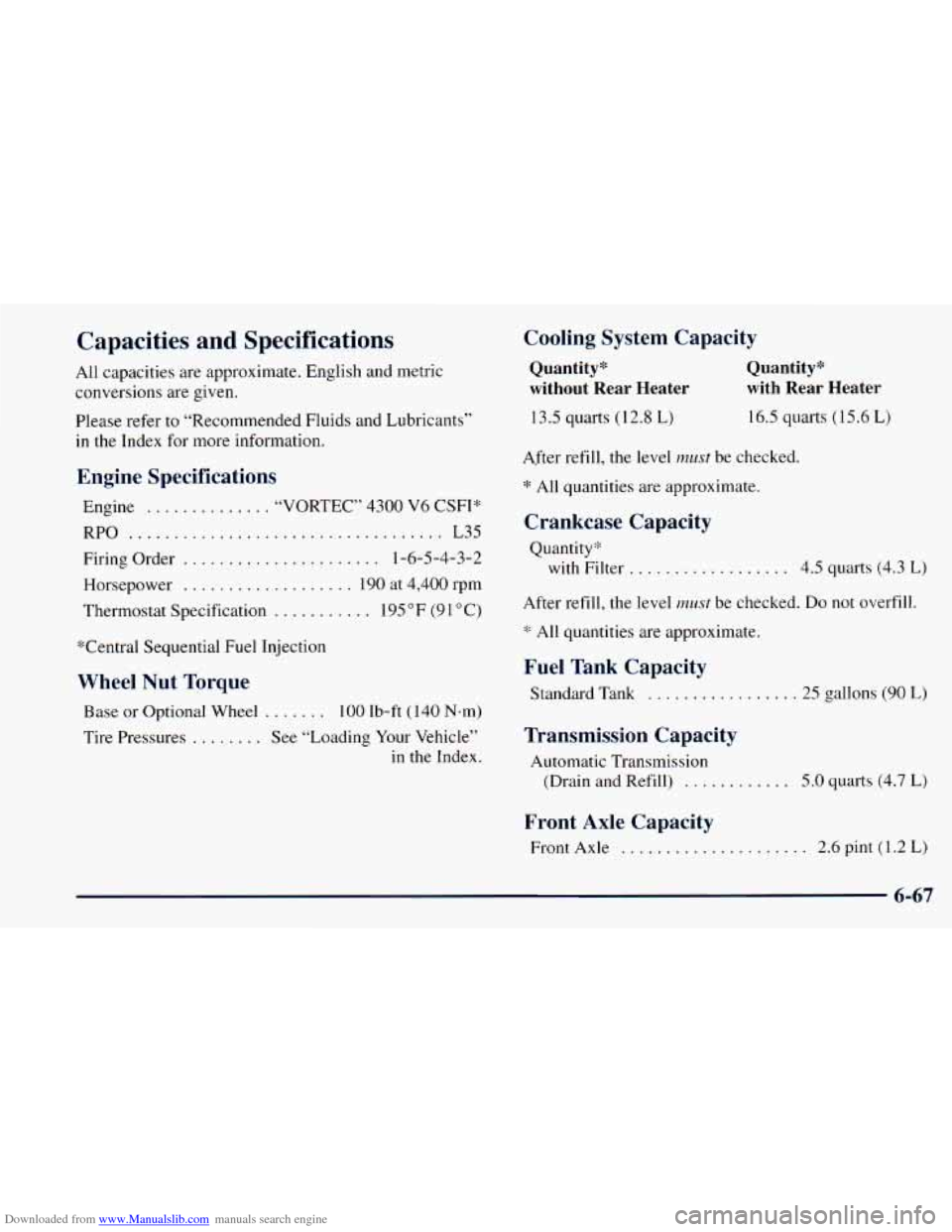
Downloaded from www.Manualslib.com manuals search engine Capacities and Specifications
All capacities are approximate. English and metric
conversions are given.
Please refer to “Recommended Fluids and Lubricants”
in the Index for more information.
Engine Specifications
Engine .............. “VORTEC” 4300 V6 CSFI*
RPO
................................. L35
Firing Order
...................... 1-6-5-4-3-2
Thermostat Specification
........... 195 OF (9 1 O C)
Horsepower
................... 190 at
4,400 rpm
*Central Sequential
Fuel Injection
Wheel Nut Torque
Tire Pressures ........ See “Loading Your Vehicle”
Base
or Optional Wheel ....... 100 lb-ft
(140 N-m)
in the Index.
Cooling System Capacity
Quantity” Quantity”
without Rear Heater with Rear Heater
13.5 quarts (12.8 L) 16.5 quarts (15.6 L)
After refill, the level
must be checked,
* All quantities are approximate.
Crankcase Capacity
Quantity”
with Filter
..... ........... 4.5 quarts (4.3 L)
After refill, the level
must be checked. Do not overfill.
* All quantities are approximate.
Fuel Tank Capacity
Standard Tank ................ .25 gallons (90 L)
Transmission Capacity
Automatic Transmission
(Drain and Refill)
............ 5.0 quarts (4.7 L)
Front Axle Capacity
Front Axle .......... . . 2.6 pint (1.2 L)
6-67
Page 345 of 414
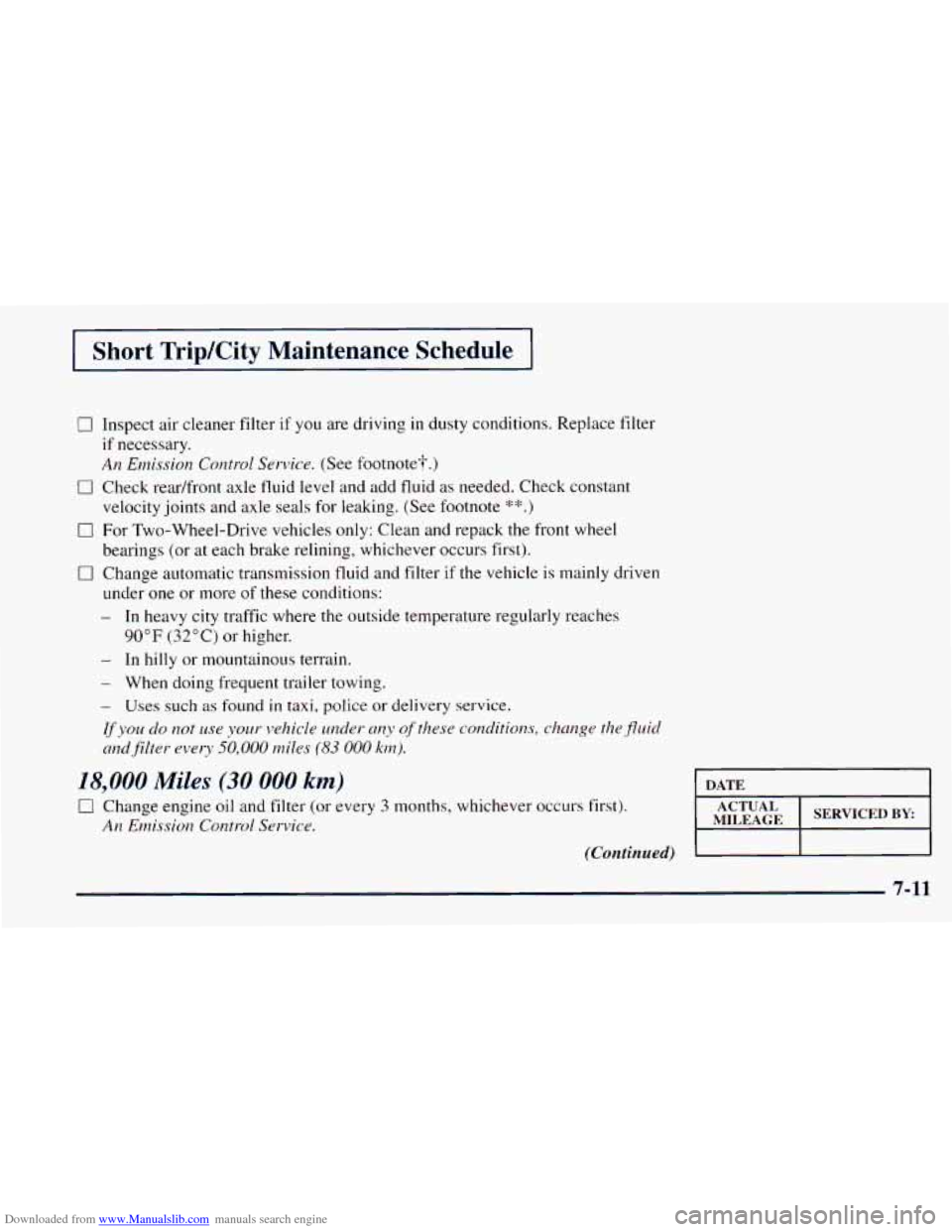
Downloaded from www.Manualslib.com manuals search engine 1 Short TripKity Maintenance Schedule I
0 Inspect air cleaner filter if you are driving in dusty conditions. Replace filter
if necessary.
An Emission Control Service. (See footnote?.)
velocity joints and axle seals for leaking. (See footnote
**.)
bearings (or at each brake relining, whichever occurs first).
under
one or more of these conditions:
0 Check readfront axle fluid level and add fluid as needed. Check constant
0 For Two-Wheel-Drive vehicles only: Clean and repack the front wheel
0 Change automatic transmission fluid and filter if the vehicle is mainly driven
- In heavy city traffic where the outside temperature regularly reaches
- In hilly or mountainous terrain.
- When doing frequent trailer towing.
90 OF (32 O C) or higher.
- Uses such as found in taxi, police or delivery service.
If you do not use yaw- vehicle under any of these conditions, change thejiruid
andfilter every
50,000 miles (83 000 km).
18,000 Miles (30 000 km)
0 Change engine oil and filter (or every 3 months, whichever occurs first).
An Emission Control Service.
7-11
Page 348 of 414
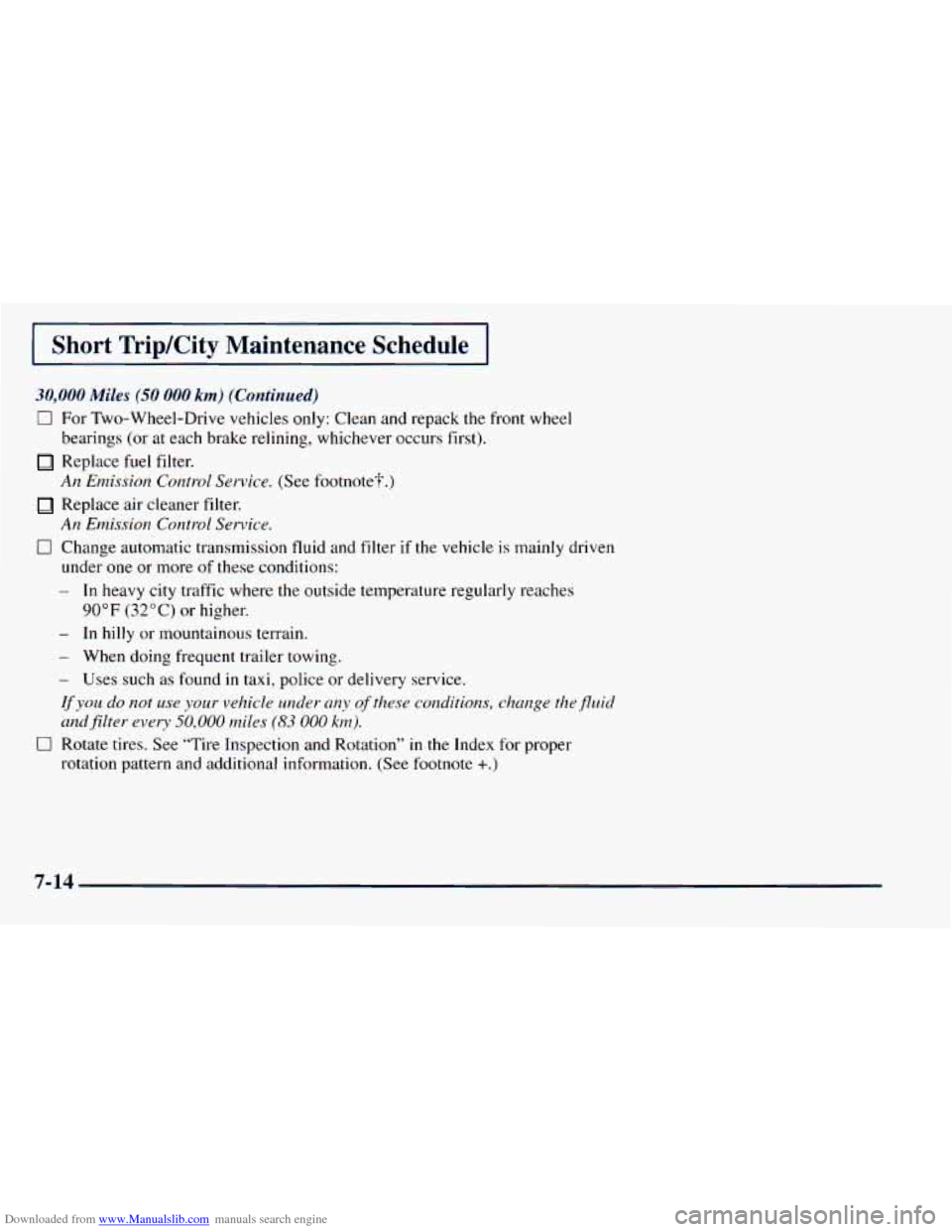
Downloaded from www.Manualslib.com manuals search engine I Short TripKity Maintenance Schedule I
30,000 Miles (50 000 km) (Continued)
0
0
0
For Two-Wheel-Drive vehicles only: Clean and repack the front wheel
bearings (or at each brake relining, whichever occurs first).
Replace
fuel filter.
An Emission Control Service. (See footnote+.)
Replace air cleaner filter.
An Emission Control Service.
Change automatic transmission fluid and filter if the vehicle is mainly driven
under one or more of these conditions:
- In heavy city traffic where the outside temperature regularly reaches
- In hilly or mountainous terrain.
- When doing frequent trailer towing.
- Uses such as found in taxi, police or delivery service.
If you do not use your vehicle under any of these conditions, change the fluid
and.filter every
50,000 miles (83 000 km).
Rotate tires. See “Tire Inspection and Rotation” in the Index for proper
rotation pattern and additional information. (See footnote
+.)
90°F (32°C) or higher.
7-14
Page 351 of 414
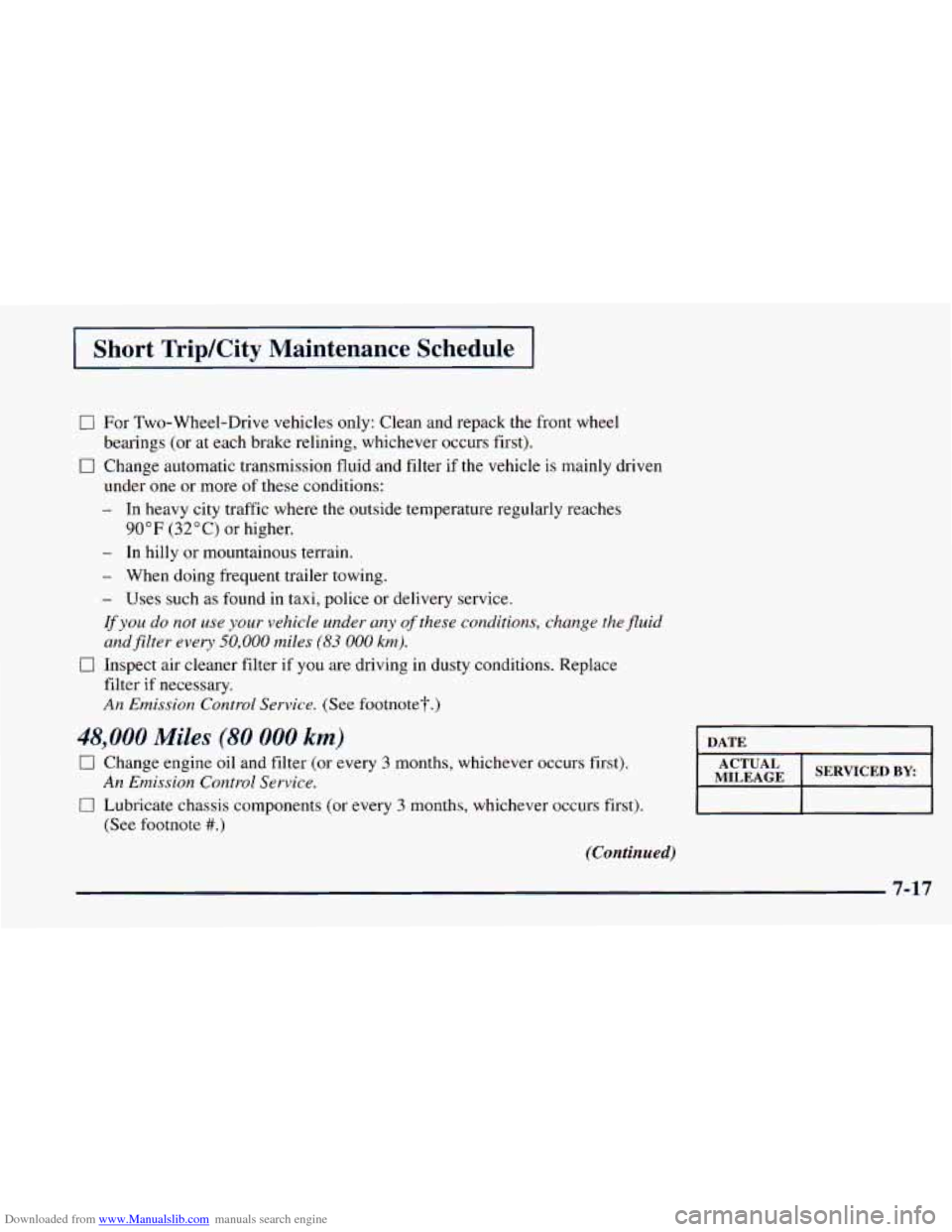
Downloaded from www.Manualslib.com manuals search engine I Short TripKity Maintenance Schedule 1
0 For Two-Wheel-Drive vehicles only: Clean and repack the front wheel
0 Change automatic transmission fluid and filter if the vehicle is mainly driven
bearings
(or at each brake relining, whichever occurs first),
under one
or more of these conditions:
- In heavy city traffic where the outside temperature regularly reaches
- In hilly or mountainous terrain.
- When doing frequent trailer towing.
- Uses such as found in taxi, police or delivery service.
If you do not use your vehicle under any of these conditions, change the fluid
andfilter every
50,000 miles (83 000 km).
filter if necessary.
An Emission Control Service. (See footnote?.)
90°F (32°C) or higher.
0 Inspect air cleaner filter if you are driving in dusty conditions. Replace
48,000 Miles (80 000 km)
0 Change engine oil and filter (or every 3 months, whichever occurs first).
0 Lubricate chassis components (or every 3 months, whichever occurs first).
An Emission Control Service.
(See footnote #.)
(Continued)
DATE
MILEAGE
ACTUAL SERVICED BY:
7-17
Page 352 of 414
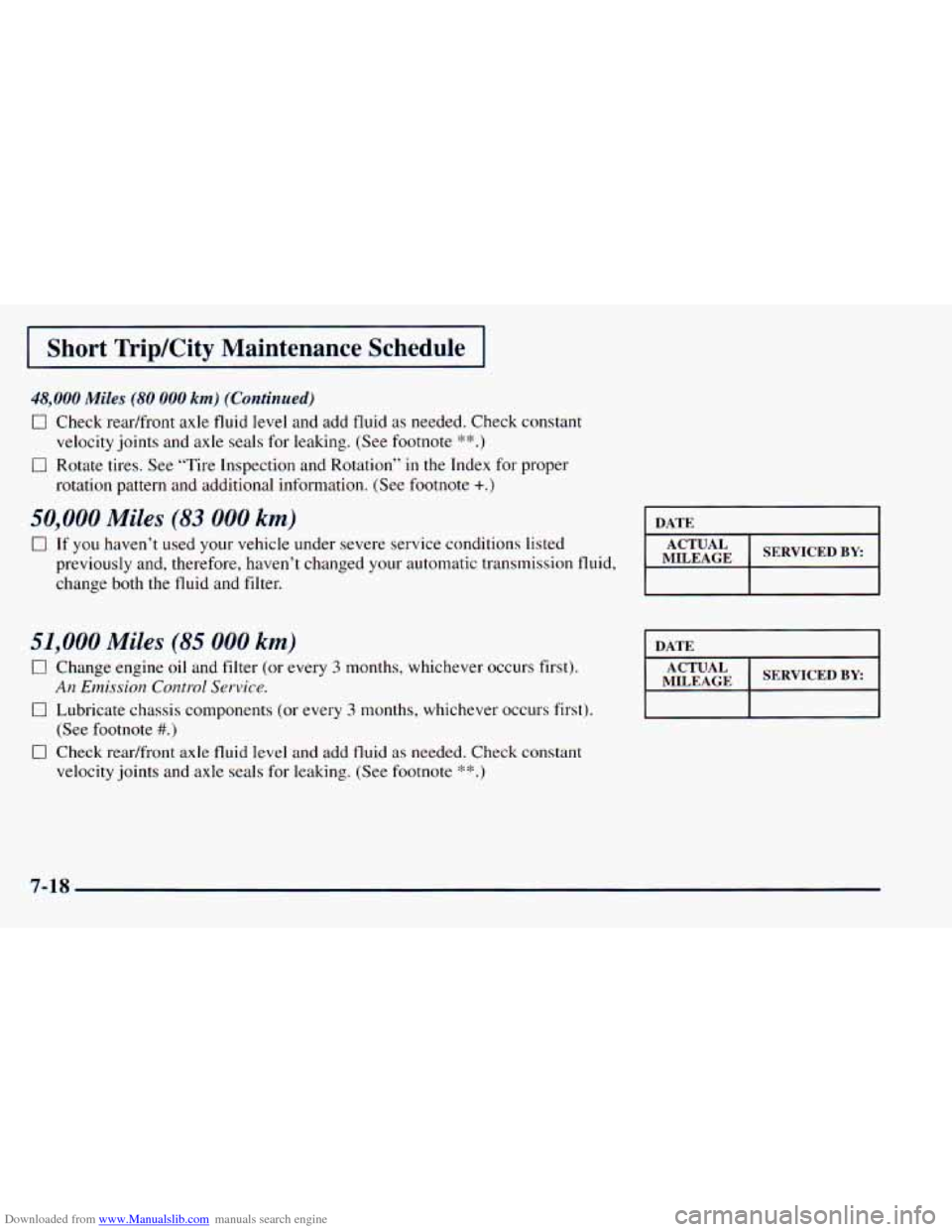
Downloaded from www.Manualslib.com manuals search engine I Short TripKity Maintenance Schedule I
48,000 Miles (80 000 km) (Continued)
0 Check readfront axle fluid level and add fluid as needed. Check constant
0 Rotate tires. See “Tire Inspection and Rotation” in the Index for proper
velocity
joints and axle seals for leaking. (See footnote
*4:.)
rotation pattern and additional information. (See footnote +.)
50,000 Miles (83 000 km) DATE
0 If you haven’t used your vehicle under severe service conditions listed
MILEAGE
ACTUAL SERVICED BY previously and, therefore, haven’t changed your automatic transmission fluid,
change both the fluid and filter.
1
51,000 Miles (85 000 km)
0 Change engine oil and filter (or every 3 months, whichever occurs first).
0 Lubricate chassis components (or every 3 months, whichever occurs first).
0 Check readfront axle fluid level and add fluid as needed. Check constant
An Emission Control Service.
(See footnote #.)
velocity joints and axle seals for leaking. (See footnote ‘$‘I:.)
DATE I
MILEAGE
ACTUAL SERVICED BY:
7-18